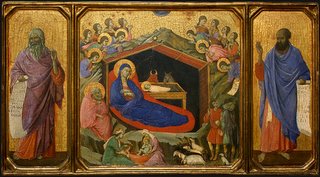El Niño Turns Five
I listened again yesterday morning to John Adams And Peter Sellars's El Niño, which received its world premiere five years ago this week in Paris. (I heard the work, live, the following year in Berlin in a performance under Kent Nagano which included Willard White, but unfortunately did not include Dawn Upshaw or Lorraine Hunt Lieberson.)
Nonesuch Recordings is to be highly commended for including music writer Michael Steinberg's brilliant and substantial interpretive essay on the new nativity oratorio. (It is an essay which didn't quite make the deadline for the last of Mr Steinberg's trilogy of listening guide studies on the symphony, the concerto, and the oratorio -- Choral Masterworks. A Listener's Guide, Oxford University Press, 2005.)
Yesterday, I also enjoyed reading Mr Steinberg's essay, from his latest collection, on Charles Wuorinen's Genesis oratorio, commissioned by Herbert Blomstedt and the San Francisco Orchestra and Chorus. I do not believe that I have ever heard this choral work, and I would very much like to.
I was sorry to see that the late Donald Martino's Paradiso Choruses did not make Mr Steinberg's study. Perhaps it will be included in a revised edition.

Duccio di Buoninsegna
The Nativity with the Prophets Isaiah and Ezekiel, 1308/1311
The National Gallery of Art, Washington, D.C. Andrew W. Mellon Collection
Acquired 1937.
[Click on Image for greater detail.]
"The Nativity, flanked by Old Testament prophets who foretold the birth of Jesus, was on the front of the Maestà, the altarpiece at Siena cathedral. It was one of the scenes from Christ’s childhood painted above and below the central image of Mary enthroned in a crowd of saints and angels. Devotion to the Virgin, who was patron saint of Siena, increased with the new interest in Christ’s humanity and the surge of popular religion that grew around mendicant preachers. By including a large devotional image of the Virgin with a story-telling scene that had traditionally been painted on church walls, the Maestà combined the functions of both icon and narrative art.
A blend of Byzantine and other influences characterizes Duccio’s style. Many of his motifs seem to be based on Byzantine manuscript illuminations. The cave setting, for example, is typically Byzantine. Duccio, however, added a manger roof similar to ones found in the Gothic art of northern Europe. Though he used the gold background of Byzantine painting, he was nevertheless keenly attuned to a specific sense of place, carefully repeating outdoor settings to give continuity from one scene to the next. While the effect of gold and brilliant colors is highly decorative, the elegant lines that define drapery folds and Duccio’s undulating brushstrokes soften the austerity of the Byzantine style."
For further information on this work, please see: http://www.nga.gov/collection/gallery/gg1/gg1-14.0.html
Image and text credit: National Gallery of Art, Washington, D.C.
Nonesuch Recordings is to be highly commended for including music writer Michael Steinberg's brilliant and substantial interpretive essay on the new nativity oratorio. (It is an essay which didn't quite make the deadline for the last of Mr Steinberg's trilogy of listening guide studies on the symphony, the concerto, and the oratorio -- Choral Masterworks. A Listener's Guide, Oxford University Press, 2005.)
Yesterday, I also enjoyed reading Mr Steinberg's essay, from his latest collection, on Charles Wuorinen's Genesis oratorio, commissioned by Herbert Blomstedt and the San Francisco Orchestra and Chorus. I do not believe that I have ever heard this choral work, and I would very much like to.
I was sorry to see that the late Donald Martino's Paradiso Choruses did not make Mr Steinberg's study. Perhaps it will be included in a revised edition.

Duccio di Buoninsegna
The Nativity with the Prophets Isaiah and Ezekiel, 1308/1311
The National Gallery of Art, Washington, D.C. Andrew W. Mellon Collection
Acquired 1937.
[Click on Image for greater detail.]
"The Nativity, flanked by Old Testament prophets who foretold the birth of Jesus, was on the front of the Maestà, the altarpiece at Siena cathedral. It was one of the scenes from Christ’s childhood painted above and below the central image of Mary enthroned in a crowd of saints and angels. Devotion to the Virgin, who was patron saint of Siena, increased with the new interest in Christ’s humanity and the surge of popular religion that grew around mendicant preachers. By including a large devotional image of the Virgin with a story-telling scene that had traditionally been painted on church walls, the Maestà combined the functions of both icon and narrative art.
A blend of Byzantine and other influences characterizes Duccio’s style. Many of his motifs seem to be based on Byzantine manuscript illuminations. The cave setting, for example, is typically Byzantine. Duccio, however, added a manger roof similar to ones found in the Gothic art of northern Europe. Though he used the gold background of Byzantine painting, he was nevertheless keenly attuned to a specific sense of place, carefully repeating outdoor settings to give continuity from one scene to the next. While the effect of gold and brilliant colors is highly decorative, the elegant lines that define drapery folds and Duccio’s undulating brushstrokes soften the austerity of the Byzantine style."
For further information on this work, please see: http://www.nga.gov/collection/gallery/gg1/gg1-14.0.html
Image and text credit: National Gallery of Art, Washington, D.C.


0 Comments:
Post a Comment
<< Home